2018
First aid
First aid for mental health problems
 In 2018, a new project was started in collaboration with the Flemish social care network Zorgnet-Icuro and various partners within the mental health context in Flanders (1), to develop a manual for first aid in case of mental health problems. This manual aspires to provide an overall first aid strategy for mental health problems as a whole, within the context of the Flemish region of Belgium. In addition, it also contains which first aid steps should be taken during a number of very specific events and conditions, such as grief, depression, eating disorders and addiction.
In 2018, a new project was started in collaboration with the Flemish social care network Zorgnet-Icuro and various partners within the mental health context in Flanders (1), to develop a manual for first aid in case of mental health problems. This manual aspires to provide an overall first aid strategy for mental health problems as a whole, within the context of the Flemish region of Belgium. In addition, it also contains which first aid steps should be taken during a number of very specific events and conditions, such as grief, depression, eating disorders and addiction.
In a first phase, a total of 27729 references were screened to identify the best available evidence on the appropriate first aid responses for each of the events and conditions (e.g. what is the best first aid response for someone who has recently lost a loved one and is grieving?). Based on our evidence summaries, a draft manual will be written in 2019, which will be presented to a panel of experts. These experts will provide feedback on the draft manual, and changes will be made appropriately. In the second half of 2019, the manual on first aid for mental health problems will be developed and pilot tested.
(1) The steering board for this project consists of Zorgnet-Icuro, VVGG (Vlaamse Vereniging voor Geestelijke Gezondheid), FDGG (Federatie Diensten Geestelijke Gezondheid), VLESP (Vlaams Expertisecentrum Suïcidepreventie), Vlaams Instituut Gezond Leven, Vlaamse Kenniscentrum Eetexpert, VAD (Vlaams expertisecentrum voor alcohol, illegale drugs, psycho-actieve medicatie, gokken en gamen), Centrum voor Volwassen Onderwijs – Sociale School Heverlee, and Belgian Red Cross.
First aid educational materials for children in sub-Saharan Africa
In 2017, CEBaP started a project concerning the development of educational materials that can be used to train children aged 5-18 years in first aid, within the sub-Saharan African context.
We developed an evidence-based “educational pathway” that indicates at what age children are able to attain certain knowledge, skills and attitudes concerning a certain first aid topic (e.g. “Children can administer first aid correctly (skills) in the event of a choking incident from the age of 11-12 years”). In addition, we compiled a list of recommended educational methods and materials during a panel meeting with 12 African experts.
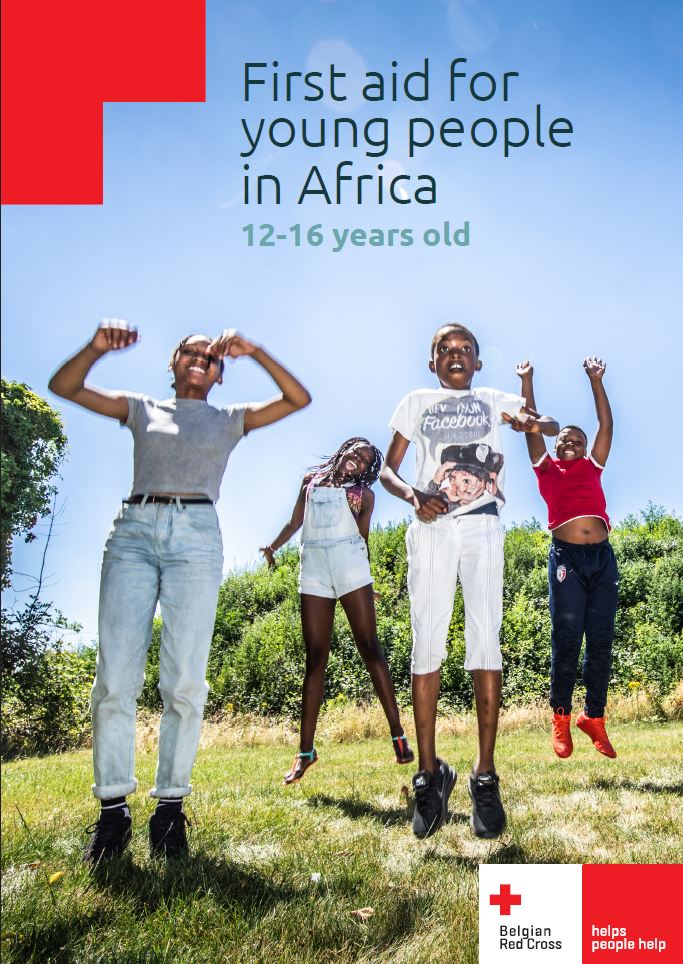 In 2018, the educational pathway in first aid has been validated by the expert panel. It can now be obtained free of charge on request via this website.
In 2018, the educational pathway in first aid has been validated by the expert panel. It can now be obtained free of charge on request via this website.
In addition, a draft manual was developed, providing first aid trainers with a range of teaching methods and educational recommendations to teach first aid to children aged 12-16 years old. In September 2018, the African expert panel was gathered for a second meeting. During this conference call, chaired by dr. Heike Geduld, the panel members gave feedback concerning the structure, lay-out, wording and educational methods used in the training manual. Moreover, they helped to further contextualize several exercises and cases used within the manual.
In a next step, the optimized first aid training manual and the related materials will be piloted in a number of schools in Zimbabwe.
Systematic reviews on first aid topics
Acute oral poisoning
Several remedies are being proposed as effective first aid techniques to treat a person who has ingested a poisonous substance. In our first aid guidelines, we only want to recommend techniques that are shown to work. To summarize all the available scientific evidence on first aid techniques for poisoning, we have conducted a systematic literature overview. This overview looked for studies conducted in actual poisoning patients, who were treated with interventions that are feasible for laypeople (e.g. inducing vomiting, providing activated charcoal). The identified evidence seems to be too low in quality to recommend any of the investigated interventions. This systematic review has been published in the Cochrane Database of Systematic reviews.

Body positioning in case of poisoning
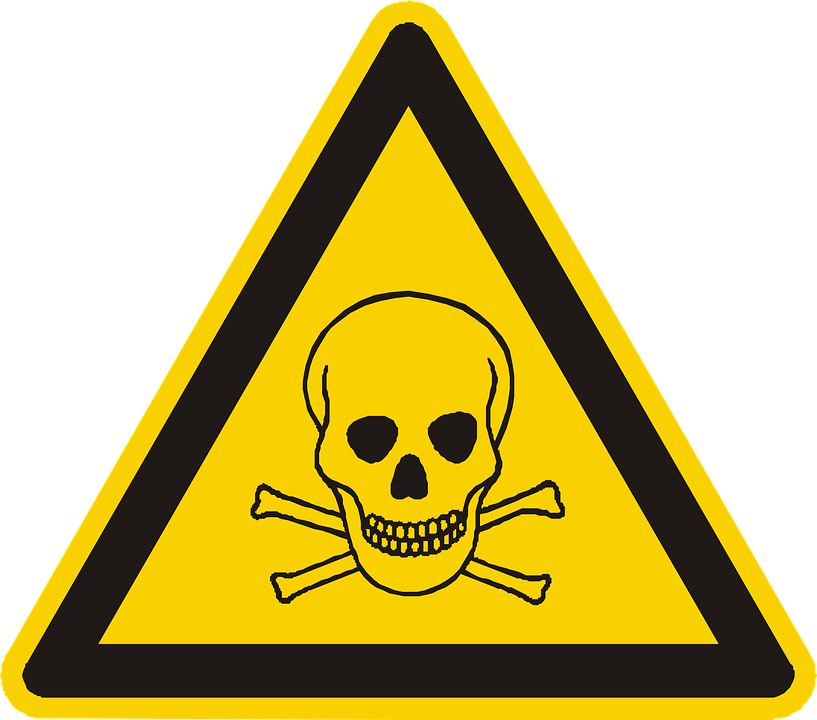 The results of our Cochrane review showed that no high-quality evidence on the treatment of oral poisoning was available in studies investigating actual poisoning patients. However, our current first aid guidelines recommend to lay a victim of poisoning on his left side, to decrease absorption of the ingested poison. To further underpin this recommendation, we have performed a systematic review on different body positions for poisoning victims.
The results of our Cochrane review showed that no high-quality evidence on the treatment of oral poisoning was available in studies investigating actual poisoning patients. However, our current first aid guidelines recommend to lay a victim of poisoning on his left side, to decrease absorption of the ingested poison. To further underpin this recommendation, we have performed a systematic review on different body positions for poisoning victims.
This review, which also included studies in healthy volunteers taking a non-toxic dose of a substance, yielded 9 studies. The results suggest that left side laying may indeed decrease the uptake of ingested substances, thereby providing scientific support to current recommendation.
This systematic review has been submitted for publication in a peer-reviewed journal.
Syncope
Vasovagal syncope or fainting is a fairly common condition, which becomes increasingly prevalent from the age of 70 years onwards. It is characterized by a prodromal phase (right before fainting), in which you feel nauseated, start sweating, have a headache, and/or become pale. The use of physical counterpressure manoeuvers during this phase shows great promise for preventing the syncope. However, the evidence has not yet been formally reviewed or synthesized. Therefore, we summarized the best available evidence on the effectiveness of physical counterpressure manoeuvers for the management of vasovagal syncope.
Eleven trials involving 688 people with vasovagal syncope showed that physical counterpressure manoeuvers reduce syncope prevalence, and increase both systolic and diastolic blood pressure. However, the quality of the evidence was considered to be low or very low. Additional high-quality studies are needed to substantiate these findings. This systematic review has been submitted for publication in a peer-reviewed journal.
Gunshot wounds
Gunshot wounds are disruptions of tissue caused by firearms. The prevalence of gun-related deaths in Europe in the period between 2000 and 2012, is approximately 6700 persons yearly. A wide range of first aid treatments have been described in literature, but specific evidence-based agreement about the best first aid treatment to be applied by laypeople or physicians in the field is lacking.
We screened 3779 references from 5 databases, and identified and withheld a total of 10 observational cohort studies, the majority of which investigated the type of pre-hospital transport. Based on the available evidence, we conclude that there is limited evidence in favour of non-Emergency Medical Services transport, including police or private vehicles. This probably reflects shorter transport times, since private vehicles might be the first vehicles on the scene. These results are in line with previous research displaying improved survival with shorter transport times in general penetrating trauma.
Blood donation and transfusion
Patient Blood Management
On 24 and 25 April 2018, an international consortium of European, American, Canadian and Australian organizations in the field of blood transfusion organized the first International Consensus Conference on Patient Blood Management (PBM) in Frankfurt, Germany. The aim of this conference was to formulate evidence-based recommendations on 3 pre-defined PBM topics: preoperative anemia, red blood cell transfusion triggers and implementation of PBM programs.
CEBaP was involved in and responsible for providing methodological support, by using the GRADE methodology to conduct systematic literature reviews on 17 PICO questions (according to the 3 selected topics) and by using a formal consensus methodology (Consensus Development Conference) to translate the evidence into recommendations.
We screened approximately 18000 potentially relevant references and finally included 145 studies. During the first day of the conference, the evidence summaries were presented during a plenary session to the general audience (around 200 medical experts from 5 continents representing >10 disciplines) followed by discussion. Subsequently, a decision-making panel (8-10 content experts together with 1 content and 1 methodological chair) formulated draft recommendations based on GRADE’s Evidence-to-Decision framework. After presenting and discussing these draft recommendations with the general audience in a plenary session on the second day, a final consensus conference statement was written by the decision-making panel. This resulted in 4 recommendations on the definition, diagnosis and treatment of preoperative anemia, 4 recommendations on the use of more restrictive RBC transfusion triggers and 2 recommendations on how to implement PBM programs. The details of these recommendations will be available in a peer-reviewed publication in 2019.

Substantiation of the medical questionnaire for blood donation
Dental treatment
In the Flemish region of Belgium, dental care is the 6th most common reason for the exclusion of blood donors. The current guidelines for deferral are based on common sense and expert opinions and are regulated by European and Belgian legislation. By performing a systematic review, we attempted to identify the best available scientific evidence on the association between transfusion transmissible infections and dental care in otherwise healthy blood donors.
A total of 1014 references were screened, finally leading to 22 included trials. We concluded that dental treatment is associated with Hepatitis B, and tooth extraction is associated with Hepatitis C. However, the evidence is of very low quality. This study therefore corroborated the current precautionary principle-driven deferral policy of blood donors after dental treatment, which involves: no deferral in case of a regular check-up, 1 day after tooth filling and 7 days after more invasive dental care, such as tooth extraction or endodontic therapy. In order to replace the current deferral policies for blood donors by evidence-based deferral policies, more high-quality primary research studies are needed. Detailed information in a peer-reviewed publication will be available in 2019.
Tattoos, piercings and/or acupuncture
Over the past decade, the frequency of having a tattoo, acupuncture and/or piercing has increased in the general population, particularly in younger individuals. Current European and USA legislation temporarily defers blood donors who received these percutaneous needle treatments from blood donation. For example, in Belgium, donors have to wait for a period of 4 months after having a tattoo, a body piercing, pierced ears or acupuncture. We performed a systematic review that aimed to scientifically underpin these deferrals by identifying the best available evidence on the association between percutaneous needle treatments and the risk of transfusion transmissible infections (TTIs).
We identified 1242 references and finally included 21 observational studies. Pooled results from meta-analyses found that percutaneous needle treatments may be associated with an increased Hepatitis B or Hepatitis C infection risk (tattooing: moderate-quality evidence; acupuncture: low-quality evidence; piercing: moderate-quality evidence). Awaiting more studies of higher quality, the current evidence together with the precautionary principle supports the current temporary exclusion of donors that have undergone a percutaneous needle procedure. Detailed information in a peer-reviewed publication will be available in 2019.
Sexual risk behaviour
Deferral policies (often of 12 months duration) for persons whose sexual behaviour puts them at risk of acquiring transfusion transmissible infections (TTIs), are commonly applied by blood transfusion services in Western countries (including Belgian Red Cross). After our systematic review on men who have sex with men (MSM) and blood donation, we aimed to conduct a systematic review to identify and synthesize the best available scientific evidence on the association between sexual risk behaviour (other than MSM) and the risk of infection by transfusion-transmissible diseases.
We screened 3750 references and finally included 15 observational studies. Meta-analyses showed that having sex with an intravenous drug user (high-quality evidence), receiving money or goods for sex (moderate- to high-quality evidence) or having a sex partner with Hepatitis/HIV (moderate-quality evidence) is probably associated with an increased risk of Hepatitis B or Hepatitis C infection. The results of this review can be used as a scientific basis for policy-makers to further scientifically underpin the current national legislation concerning sexual behaviour deferrals. Detailed information in a peer-reviewed publication will be available in 2019.
Social care
The “Friendly visiting program” of the Belgian Red Cross was designed to tackle feelings of loneliness and social isolation among older adults. By paying regular visits to isolated older adults, the Belgian Red Cross volunteers aim to combat the loneliness epidemic.
A second Belgian Red Cross project, the “Care Library”, offers a library and tailor-made services for people who, due to their care context, cannot simply visit a regular library. During their book rounds, volunteers also engage in friendly chats, puzzling, reading aloud, playing games, or reminiscing with the patient or resident.

To provide a scientific base for these activities, CEBaP performed two evidence reviews. The first one investigated the effect of friendly (home) visiting by a volunteer on the loneliness, social isolation, (symptoms of) depression, life satisfaction and mental health of older adults. The second one looked at the effect of book reading on physical and mental health in older adults.
In April 2018, this evidence base was presented to and discussed by a multidisciplinary expert panel. The panel consisted of Flemish academic and practice social care experts (including Vonk3 @Thomas More University, the Flanders Centre of Expertise on Dementia, the Flemish interface centre for cultural heritage, residential care centres and the Christian health insurance fund), as well as Belgian Red Cross volunteers who support these activities in several local chapters.
Based on the input of the expert panel, the Social Care Department of the Belgian Red Cross is currently tweaking its activities further.
Disaster preparedness
Forecast-based Financing
Early 2018, Belgian Red Cross International Cooperations Service and CEBaP started a Forecast-based Financing (FbF) research project in Mozambique. FbF aims to reduce the impact of hazardous weather events by acting in the days right before the disaster actually happens, based on weather forecasts. We collaborate with both Cruz Vermelha de Moçambique (Mozambican Red Cross) and German Red Cross to support their FbF project on floods and cyclones.
CEBaP performed a scoping review to investigate which early actions might be effective to reduce the impact of floods or cyclones and how we might best implement these in the field. Simultaneously, a research delegate from German Red Cross collected data on the impacts of previous cyclones and floods as well as suggestions for early actions in several provinces in Mozambique.
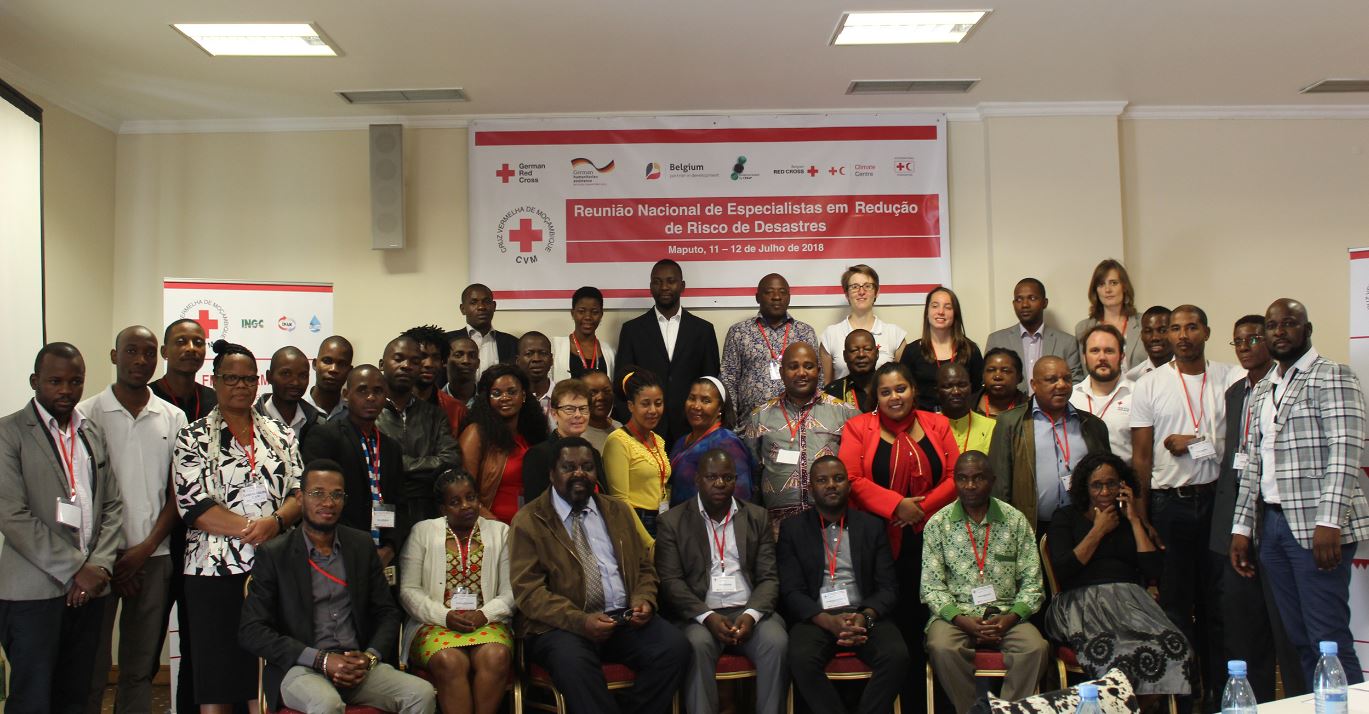 In July 2018, we travelled to Maputo and presented our results at a stakeholder meeting with Red Cross practitioners, government officials and representatives of several NGOs. The collected evidence and the input from the meeting were incorporated in the early action protocols which are currently being finalized. CEBaP is now assisting with the development of a monitoring and evaluation framework so that the early actions can be further improved upon in the future.
In July 2018, we travelled to Maputo and presented our results at a stakeholder meeting with Red Cross practitioners, government officials and representatives of several NGOs. The collected evidence and the input from the meeting were incorporated in the early action protocols which are currently being finalized. CEBaP is now assisting with the development of a monitoring and evaluation framework so that the early actions can be further improved upon in the future.
Risk classification models
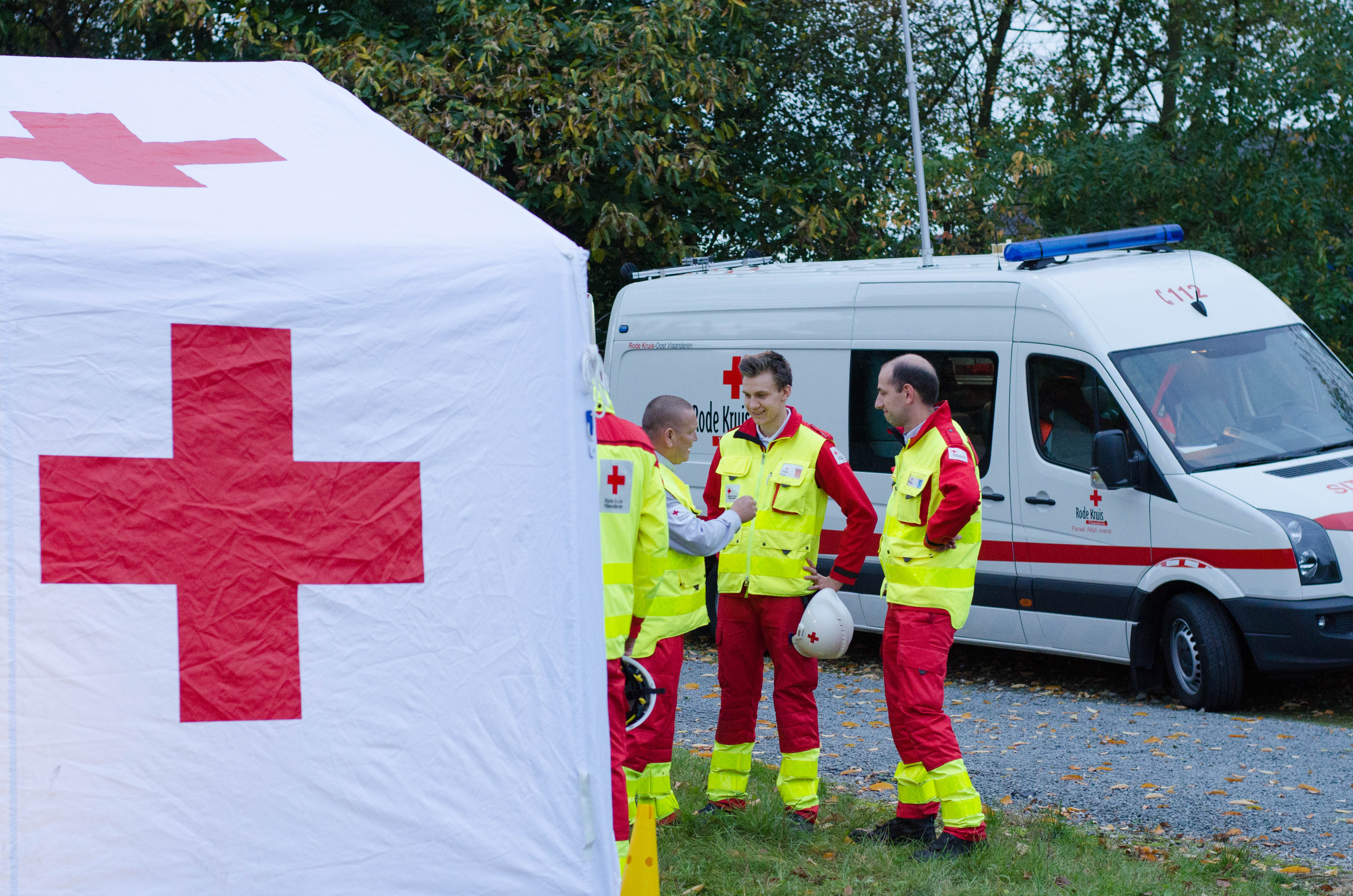 Mass gatherings attended by large crowds are an increasingly common feature of society. Every year, the Relief Service of Belgian Red Cross is present at over 8000 events (sports events, music concerts, city festivals,…) and sets up first aid posts to help/treat people. An increased number of studies have been conducted to identify those variables that are associated with increased medical usage rates.
Mass gatherings attended by large crowds are an increasingly common feature of society. Every year, the Relief Service of Belgian Red Cross is present at over 8000 events (sports events, music concerts, city festivals,…) and sets up first aid posts to help/treat people. An increased number of studies have been conducted to identify those variables that are associated with increased medical usage rates.
In 2018, we performed a systematic review to identify studies that developed and/or validated a statistical regression model predicting patient presentation rate (PPR) or transfer to hospital rate (TTHR) at mass gatherings.
Eleven prediction modelling studies were identified with a combined audience of over 32 million people in over 1500 mass gatherings. Eight prediction development studies found that the following variables were statistically significant to predict PPR and/or TTHR: type of accommodation, type of event, weather conditions, crowd size, time of the event, demographic variables, sports event distance, level of competition, free water availability and specific TTHR-predictive factors (number of patient presentations, type of injury). The quality of the evidence was considered as low.
Three studies externally validated their model against existing models. Two validation studies showed a large underestimation of the predicted patients presentations or transports to hospital (67-81%) whereas one study overestimated these outcomes with 10-28%.
This systematic review identified a comprehensive list of relevant predictors which should be measured to develop and validate future models to predict medical usage at mass gatherings. This will further scientifically underpin more effective pre-event planning and resource provision.
Primary field research
First Aid retention study in Nepal
Every year, the Red Cross/Red Crescent societies train hundreds of thousands of people in first aid around the world. Because evidence about the retention of first aid knowledge and skills in laypeople is limited, we investigated this ourselves, together with the Nepal Red Cross Society. More than 500 people participated in our randomized controlled trial on retention of non-resuscitative first aid and cardiopulmonary resuscitation (CPR) over a period of two years.
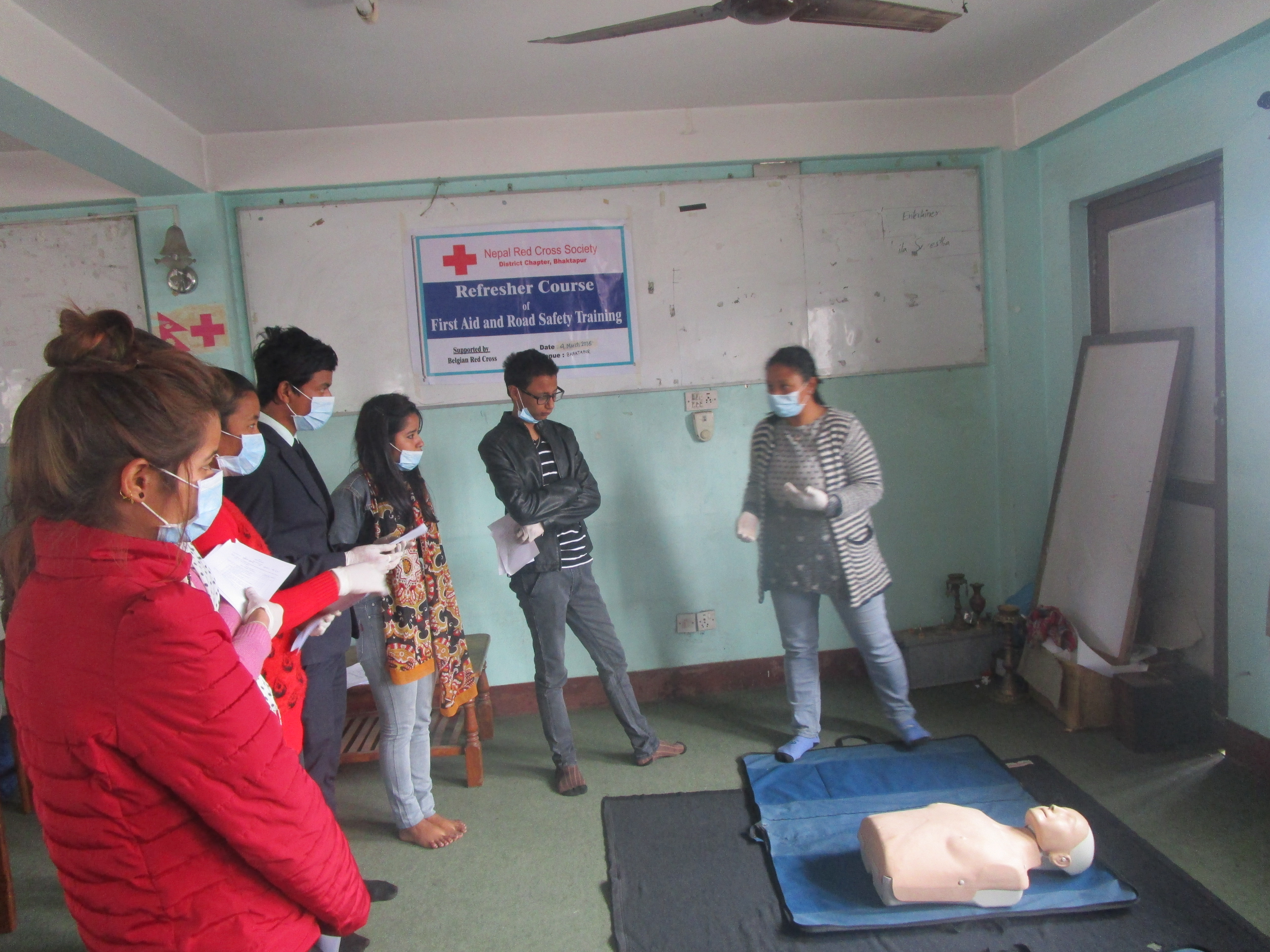 One year after a 4-day basic first aid course, half of the participants received an active one-day refresher course, whereas the other half received a control refresher course. The former reiterated several theoretical first aid topics and practical skills for bleeding, whereas the latter refreshed practical skills for fractures but no relevant theoretical knowledge.
One year after a 4-day basic first aid course, half of the participants received an active one-day refresher course, whereas the other half received a control refresher course. The former reiterated several theoretical first aid topics and practical skills for bleeding, whereas the latter refreshed practical skills for fractures but no relevant theoretical knowledge.
In both groups, practical CPR skills were refreshed.
We assessed theoretical knowledge and practical skills immediately before and after the basic first aid course, immediately before and after the refresher course (one year after the basic course), and one last time two years after the basic course.
Not surprisingly, first aid knowledge increased dramatically after the basic first aid course. Afterwards, knowledge declined over time in the control group, but the active refresher group showed retention (or, at least, less decline) of first aid knowledge up to one year after the refresher course. CPR skills were well retained in both groups, and clearly higher than those of participants who did not attend the refresher course after one year, but participated to the final test after two years. We conclude from our study that retention in first aid knowledge and skills decreases over two years’ time. A refresher after one year seems to have modest effects on first aid knowledge and CPR skills. Our results support providing annual refreshers.
WASH impact study Tanzania
Each year, approximately 1.7 billion children globally are faced with diarrheal disease. Children under five years of age are particularly vulnerable, with 525000 mortalities per year. Unsafe drinking water, poor sanitation, and insufficient hygiene are responsible for nearly 90% of these mortalities. However, by means of ‘Water, Sanitation, and Hygiene’ (WASH) interventions, the risk of diarrheal disease can be significantly reduced.
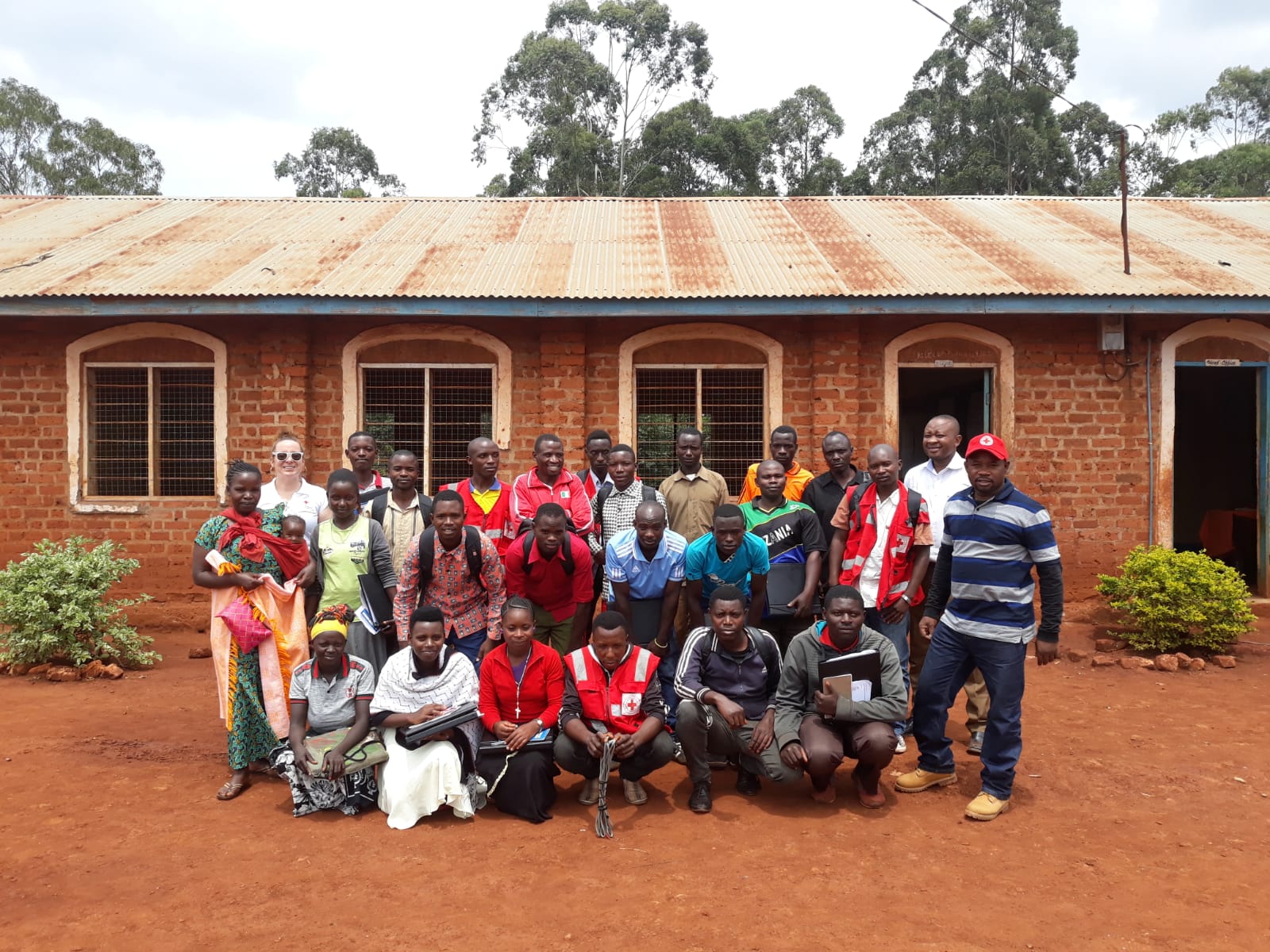 In collaboration with the Tanzania Red Cross Society, we are investigating the effectiveness of contextualized versus non-contextualized WASH promotion interventions for improving hand washing, sanitation, and related health in rural Tanzania. Within a contextualized intervention, information about the needs of the population are gathered and used to adapt the intervention accordingly. In contrast, a non-contextualized intervention is pre-defined and thus not specifically tailored to the population needs.
In collaboration with the Tanzania Red Cross Society, we are investigating the effectiveness of contextualized versus non-contextualized WASH promotion interventions for improving hand washing, sanitation, and related health in rural Tanzania. Within a contextualized intervention, information about the needs of the population are gathered and used to adapt the intervention accordingly. In contrast, a non-contextualized intervention is pre-defined and thus not specifically tailored to the population needs.
A total of 1500 households participate in this cluster randomized controlled trial. They are subdivided into three cohorts, receiving either: (1) a contextualized WASH intervention, (2) a non-contextualized WASH intervention, or (3) a placebo intervention. Over a period of 3 years, participants will be tested 4 times. At this point in time, the baseline measurement has taken place and interventions are being implemented. In May 2019, the first results of the midline survey are expected.
